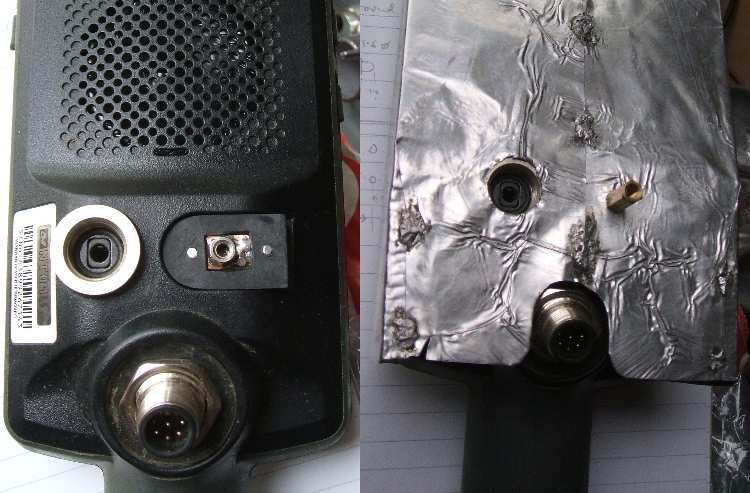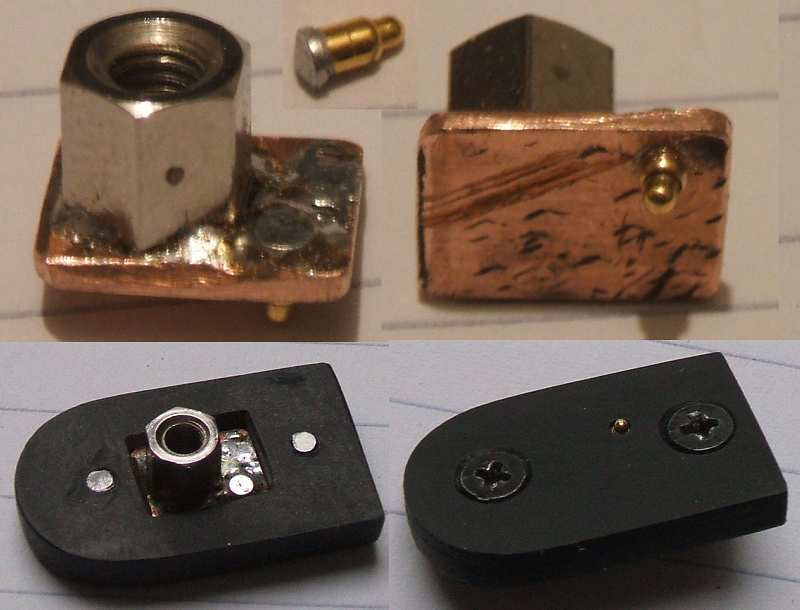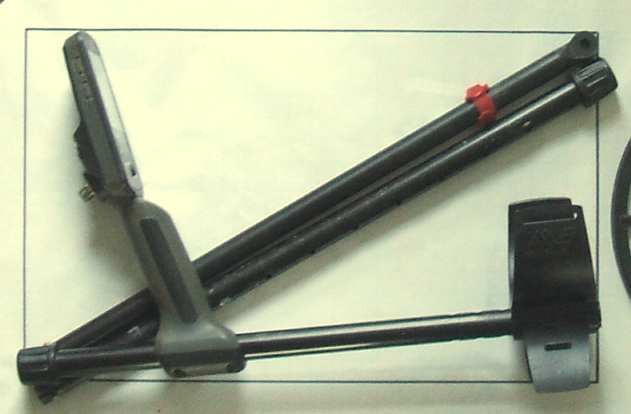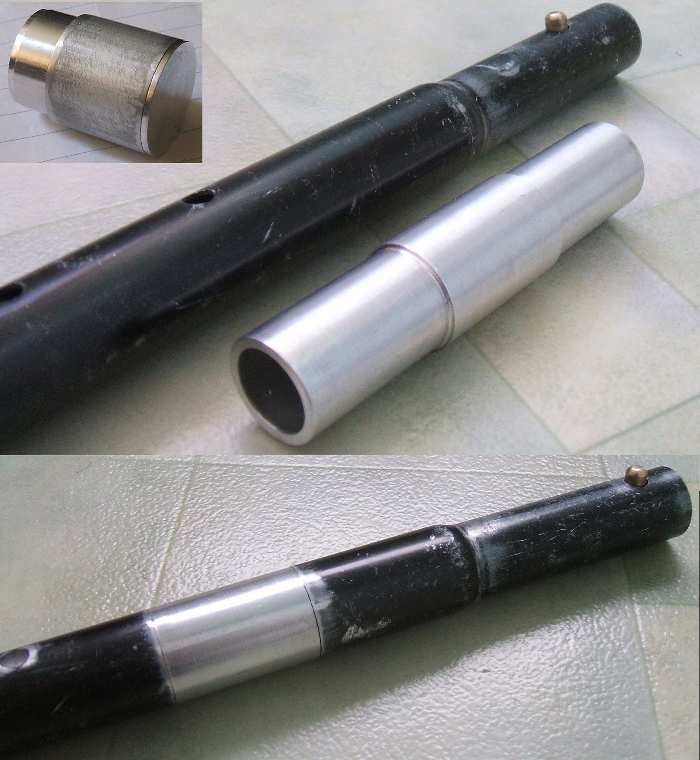-
Posts
565 -
Joined
-
Last visited
Content Type
Forums
Detector Prospector Home
Detector Database
Downloads
Everything posted by PimentoUK
-

Rechargeable Aa 1.5v Batteries
PimentoUK replied to kac's topic in Metal Detector Advice & Comparisons
"Do they last longer by 1 1/2 times because they don't fade power like an alkaline cell?" Basically, yes. The currents mentioned earlier of 0.5 Amps are pretty hard for little AA cells, especially continuously, so alkaline's don't give anywhere near their full capacity. I recall they're typically 2500 mAh at modest discharge rates ( 10 + hours ). Whereas rechargeable AA's, regardless of whether they're NiCad, MiMH, Li-Ion, all have very low internal resistance , and can put out modestly high currents with minimal fading, until they finally go flat, quickly. For interest, here's a disassembly of the 'KentLi' version of these '1.5V' types, showing that it's a cylindrical 'foil-pouch' cell, slightly smaller than the AA package it fits in: http://dangerousprototypes.com/blog/2014/12/23/teardown-of-kentli-ph5-1-5-v-li-ion-aa-battery/ Foil-pouch cells can easily be made in any size, so odd under-length variants, and uncommon diameters are all possible. It's possible the Blackube cells use this type of internals, as the have a nonstandard short length cell internally. -
I finished off the dooberry that allows my foil hat to be connected to the electronics ground of the Eqx at the USB port. Pictures have been added to my earlier post. A brass spacer pillar with an M3 stud on it is used to bolt the foil to the ground. The hat can be used alone, or the dooberry fitted and the hat grounded. There may be enough wiggle-room to slide the dooberry along 2mm and break the spring-pip connection, in which case the with/without ground experiment is greatly simplified.
-

Rechargeable Aa 1.5v Batteries
PimentoUK replied to kac's topic in Metal Detector Advice & Comparisons
You guys need to pay close attention to the specs of these cells, with regards to mAh and mWh... milliamp-hour and milliwatt-hour. mWh = mAh x cell voltage ( 1.5V here ) So those 'Blackube' cells described as 2250 mWh are actually 1500 mAh, nothing too special, though clearly the cell is only two-thirds 'full', as there's a USB port on the side. Likewise, those 'AmpTorrent' cells are 3000 mWh , equivalent to 2000 mAh, which is quite respectable. This is because the cell occupies nearly all the space in the package, perhaps just 1mm at the end for the regulator electronics board. The special charger makes direct contact with the 3.6V cell, usually there's an exposed ring of metal around the positive pip. The lithium cells the AmpTorrent ( and probably the KentLi type, and others ) are based around are known as 14500 size, basically AA, with no pip. The best of these come in at about 900 mAh, maybe 1000 mAh, working out as 3300 mWh. With the 1.5V regulator circuit, they end up producing 2000 mAh at 1.5V. -

New Prototype Detector - My First Analog Attempt
PimentoUK replied to Sun-Boy's topic in Metal Detector Advice & Comparisons
Unfortunately, Litz wire is hard to come by, especially in small quantities. And there's usually not much choice, either, which is difficult when you're attempting to juggle resistance and inductance values. One UK supplier of all types of wire is wires co uk : https://www.wires.co.uk/cgi-bin/sh000001.pl?WD=litz&PN=litzwire.html#aLZ00710090_2d100 They also stock multi-stranded ecw, which could be useful as an improvised alternative to Litz. Most commercial Litz uses typically 0.035mm to 0.05mm strands, which is probably overkill for 60kHz, and 0.07mm - 0.10mm would be adequate if you're going to homebrew some. The cotton wrap ( serving ) is also not needed for detectors' low voltage use. So the simplest method is to wind multiple ecw strands together, eg. 9 strands of 0.1mm in place of one 0.3mm wire. I'm looking into making a coil for my Equinox, and that needs a Litz-like TX winding, and the prospect of making a 300 x 0.05mm bundle is one of the challenges. I'm needing about 14 metres, so obviously don't really want to purchase 100 Dollar reels of the stuff. So I'm thinking about winding jigs etc. -
Whenever these 'Digital CZ' threads appeared, I always found myself wanting a CZ/F75 mashup, a 13 / 39 kHz machine, as that is less 'high-conductor coin' specific, and more 'general-purpose' , suiting our European hunting better. Thankfully, those Australians were thinking like me, and produced a machine that ticks a lot of my boxes, it even uses 39kHz, and 13k in 'Beach' mode. "I'll dream up some more in a bit..." Some of my 'ideas' that this machine could do would include: Mixed mode with all-metal & disc-mode, at either 5k or 15k. Mixed-mode multi, with 5k and 15k together. Stereo-mode with 5k in one ear, 15k in the other. ( I'm not sure how useful this would be, but it's presumably doable )
-

New Prototype Detector - My First Analog Attempt
PimentoUK replied to Sun-Boy's topic in Metal Detector Advice & Comparisons
I'm curious about your choice of 60kHz for the operating freq. This is pretty high, and it would typically be chosen for one of two reasons: * Hunting very small gold nuggets ( or other targets that would be classed as 'low on the ID scale' , including some ancient coins ) * Hunting in extremely iron/nail-infested locations, where the high frequency tends to make the iron less 'visible' , and the chance of finding non-ferrous items increases. An example of the first case would be the Fisher GoldBug2, a dedicated nugget-hunter operating at 72 kHz. The second case is a niche which few modern machines fill. Classic examples include the Compass Yukon, running at 100 kHz. It's possible the HF coils used on the XP Deus could fill either of these two categories. 60kHz also makes experimenting with commercial coils all but impossible, as most are operated at 5 - 20 kHz. As you haven't described your coil construction, I can't offer much advice, though such a high frequency would likely benefit from the use of Litz wire ( or at least many paralleled strands of finer gauge wire ) for the TX in particular; skin effects can hinder performance. -
Mr. Nox's shiny hat is part-made, I've 'finished' the foil screen. I'd like to say how fine he looks in it, but unfortunately the aluminium soldering did not go well, there's some ugly-looking grey blobs instead. The thick foil sapped too much heat from my iron, which isn't that hot anyway. I didn't prepare the joint area, either; I'm sure rubbing it with fine aluminium oxide abrasive paper ( or possibly a glass-fibre pencil ) cleans off the oxide film and helps the solder wet the surface. Oh well. It's made from 0.1mm thick foil from a large pre-prepared food tray. It's one piece of foil, about 290mm x 160mm, folded up and soldered in a few places. With a hole for the headphone connector, and notches for the PP button and the coil cable. For info, the solder I used was Multicore Alusol 45D: https://cpc.farnell.com/multicore-solder/629443/solder-alusol-0-91mm-500g/dp/SD00059 It used to be available in a tubular plastic dispenser of 1.5 metres, at a realistic price, but now only seems to be sold as expensive 500 gram reels. However ( in the UK ) there are eBay sellers listing small packs of 1 metre lengths, maybe in your country similar deals can be had. Update: I've now finished the USB port ground-connection part. I over-engineered it, but the end result is OK. A little spring-pip just like on the Minelab USB plug, soldered to a bit of copper sheet and a length of 3mm tapped pillar make up the electrical part, giving a short direct connection between detector ground and foil screen. The plastic housing ensures the pip lines up with the USB port pad, the two steel screws line up with the magnets to hold it in place, quite firmly. The foil hat will have a 3mm hole made in it, and a M3 stud attaches it to the ground adapter.
-
It all sounds rather expensive, over-engineered and unnecessary, in my opinion. I'm planning on making mine from the thick foil that's used ( in my country .... ) for ready-prepared food. ( peel off film lid, place in oven for 45 minutes sort of food ). Then just spray paint it black so it doesn't garner attention. Gotta say that eBay listing comes with a surprising quantity of technical info on shielding, which makes a change. So many listing contain masses of legal/contractual/ T & C stuff, whilst telling you nothing about the product. I haven't made or tested my 'foil hat' yet, yet another infuriating lockdown means going out and testing it is a bit risky, though I have another alternative location that's more accessible.
-
The short extension at the elbow-cup is light, it's three-piece construction - the tube is 50 thou ( 1.25mm ) wall-thickness, the joiner is short and large-bore, the end-cap is thin and hollowed-out. There's no plastic plug, obviously. The middle-rod extender is somewhat over-engineered. The walls are 2mm thick at the insertion sections, meaning they're 3mm thick over the central 33mm length. So I could've bored it to 1.5mm, and had shorter insertion overlaps. The 33mm length could've been 8mm shorter if I'd simply moved the spring-pip 12mm, but aesthetically the under-inserted rod would look ugly. Being at the top end of the rod means the weight's not felt as much as weight lower down, closer to the coil. The shortened lower rod is of course lighter, but only by 13 grams. So overall, it is a bit heavier. But I never use the coil cover, which weighs 65 grams ( for the 11" coil ). In practice the weight gain is easily ignored. The new upper rod is tricky to make due to the thin-wall ( 1mm / 40 thou ) tubing ML use. I can only get 48 / 50 / 56 thou, so I'm going to be boring out some 50 thou over a 65mm length, before I bend it, drill it etc, to make it match the middle rod. Edit: I have no plans for a folding/removeable control box, as the 10.5" coil is the limiting factor in that direction. It would've been nice if the handgrip/control-box assembly was 10-15mm ( 0.5" ) shorter, but it is what it is.
-
On the current Eqx, the pip-locating holes on the middle shaft are spaced 40mm apart, which I think is too far, and a spacing of about 30mm would be better if the new machines share this shaft style. Unrelated: Some people obviously like the XP GMP / Deus style of audio, which I understand has also been 'replicated' on other machines, possibly the DeepTech Vista? . A sort of all-metal with rolling tone-ID changes, leaving the user to make the decisions re: dig/no-dig. It would be worth ML considering this as an audio option on future machines. I'm certain it's achievable in single-freq mode, but in 'Multi', I've no idea.
-
In the thread about possible design improvements for the Equinox series, I said the breakdown of the three-piece shaft could be improved. It currently has two reasonably short upper parts, and one excessively long lower rod. To improve packing, the upper rods need to be a bit longer, and the lower rod shortened. Having done this exercise on my Fisher F75 shaft, I turned my design ideas to the Eqx. The upper rod obviously has the 'height', due to the control pod and lower stand, and this limits the compactness to 28cm / 11" in that direction. This is slightly larger than the coil, which measures 10.5" on its shortest diameter. The middle rod will pack diagonally, meaning it can be about 7cm / 2.5" longer than the upper rod. I also decided that the insertion overlaps of the lower rod, and the middle rod, could be reduced by a total of about 2.5cm / 1". So my design ended up with the upper shaft 2.5cm / 1" longer; the middle rod 2.5cm / 1" longer with 12mm / 0.5" less insertion; and the lower rod shortened by 80mm / 3.1" , with 12mm less insertion. Practically speaking, the upper rod was extended at the rear end with a bit of lathe work, with two new holes for the elbow-cup. The handgrip was moved back 2.5cm / 1", needing one new hole drilling. The middle rod was a bit more complex. I machined an extender piece that adds 33mm to the top end of the rod, trimmed 8mm off the insertion section, and moved the pip location hole 5mm towards the rod end. This makes the rod effectively 38mm longer, but only physically 25mm longer. Trimming 80mm off the carbon rod and making the new pip-hole 12mm closer to the end completes that job. The end result is the detector will pack in a 47cm x 28cm ( 18.5" x 11" ) space, see pic below. Individual rod lengths are: Upper = 47cm ; Lower & middle = 53.5cm ( 18.5" & 21" ) I ultimately intend making a new upper rod, with a bend below the handgrip, offsetting the coil and lower rod sections, which will deal with the twisting issue that's been previously discussed here and elsewhere.
-

New Prototype Detector - My First Analog Attempt
PimentoUK replied to Sun-Boy's topic in Metal Detector Advice & Comparisons
"A question: When I see guys using their machines, they have to be swinging in order to get a signal, is this the case with most VLF detectors? Can you guys give me a quick rundown on some of the machines and how they detect?" Nearly all commercially available VLF machines are 'motion mode' in operation, except when in 'pinpoint mode'. A few have a 'permanent pinpoint mode' as a feature, such as the Fisher F75. One manufacturer that still makes a range of true non-motion machines is C-Scope in the United Kingdom, the CS1220XD is the flagship of the models: https://www.csmetaldetectors.com/shop/category/non-motion-metal-detectors -

New Prototype Detector - My First Analog Attempt
PimentoUK replied to Sun-Boy's topic in Metal Detector Advice & Comparisons
Geotech1 seem to get spammer problems, but their security methods to tackle it made it tougher to register for everyone else. There is this page that may help: https://www.geotech1.com/forums/showthread.php?24472 -

I've Been Killing It On Super Deep Silver
PimentoUK replied to longbow62's topic in Minelab Equinox Forum
@Longbow62: Should we assume you're using the stock 11" coil ? Do you have the large coil ? Have you considered buying one? -

New Prototype Detector - My First Analog Attempt
PimentoUK replied to Sun-Boy's topic in Metal Detector Advice & Comparisons
As an electronics engineer, I have to say your project is very neat and well planned. Are you a member of Carl & George's "Geotech1 Forum" ? It's a useful resource, if nothing else, and there's always the angry Lithuanian/Bulgarian/ etc guys to keep the place entertaining. Re: the coil. I would advise designing your machine to work with a known good commercial coil, then when you're confident it's working OK, consider making your own coil. Your chances of success are much improved that way. -
Here's the BBC's version of the story: https://www.bbc.co.uk/news/uk-wales-46179570 Every one of those old-time miners is named Dai ...[humour] It is possible to pan the rivers for gold, but I'm sure it's just flecks, not detectable stuff. But even that can land you in trouble: https://www.theguardian.com/uk-news/2018/may/10/police-investigate-gold-panning-welsh-river
-

Has The Sea Ghost Housing Been Discussed On This Forum?
PimentoUK replied to nickelNdimed's topic in Minelab Equinox Forum
I assume there's three 18650's in parallel, so if the best available types with 3400 mAh capacity are used, that's 10200 mAh , which is about double the nominal 5000 mAh capacity of the 26650 size. Even if more modest 2400 mAh cells were used, that's still 7200 mAh, with estimated 19 hours run-time. -

Has The Sea Ghost Housing Been Discussed On This Forum?
PimentoUK replied to nickelNdimed's topic in Minelab Equinox Forum
An interesting question, BigSky Guy. The 8-pin coil connector only uses 7 pins, there's a spare. And the 0 Volt/ground of the USB port appears to be connected to one of the coil pins ( transmit cold ). So in principle, the spare pin could connect to the 5 Volt of the USB port. That then allows you to charge the battery through the coil connector. However, it's worth noting he's used an 8-pin connector for the audio output, even though it only needs 3 pins .... so perhaps he's simply wired all 4 USB pins to that connector ( and just leaving one spare pin ) -
Quote: "I think (could be wrong...) a rough rule-of-thumb is that an opening in a conductive shield should be smaller than the wavelength of the incident wave in order to be effective. A 2.4 GHz EM wave has a wavelength of 125 mm." Unfortunately not. The rule-of-thumb I use is to keep the aperture size below 0.1 wavelength, but the experts seem to prefer even smaller sizes. There's a reason microwave ovens have very small holes in the window screen. Here's one online guide, (though they are manufacturers of screening products, so are naturally going to encourage people to be thorough ) https://leadertechinc.com/blog/how-apertures-affect-emi-shielding/ So your shielding would have to be pretty good to seriously block the 2.4GHz Blutooth etc radio links, but they are pretty low power short-range links, so any attenuation may cause problems. I'm not sure using wired headphones is going to be a better option, either. The headphone cable is an antenna, that can couple RF signals directly into the control box. There's almost certainly some RF filtering on those wires inside the box, plus you could fit a ferrite filter on the headphone cable close to the plug. Using the internal loudspeaker would be the option worth trying in bad EMI.
-
My test location was going to be near a radio tower, that's bristling with directional microwave antennae, probably 5 GHz and up, but may well have lower freq cellphone gear on it, 800 MHz & up. It drives my Fisher F75 mad, I found that positioning myself so my body was between the tower and the control-box, made a significant improvement. The sight of me walking backwards across the field would no doubt have left observant onlookers puzzled. But they would probably assume I'm wierd simply for metal detecting ... so it may just be dismissed as 'fruitcake behaviour' . Adding a foil 'hat' to my detector would just confirm this. The Eqx still gets some EMI in this location ( plus probable hidden EMI ), and the body-block technique still works on it, so I think it would be a good test site for foil hats etc. I shall try and do some experiments in the next week or so.
-
Quote: "First Texas used EMI paint on the T2/F75 connected to ground to help although there are far better technologies now where they can incorporate conductive fibres when moulding the part. T2/F75 etc coils are moulded from conductive plastic. But there's shielding and there's shielding. A terrific shield is not desirable on a coil, as it stops it picking up metal objects. On the control box, anything from solid metal to low-resistance graphite is useful. The huge weak point in the T2 control-box shield is the massive hole in one side where the LCD is. There are ways of making a see-through screened panel, but it would be cost-prohibitive on a consumer metal detector. Edit: one possible 'see-through' screen material is the perforated sheet that's inside the glass window of microwave ovens. Next time I see a dumped oven, I may have to do some salvaging. I suppose I should point out that kitchen foil shields ( and metal boxes ) are not that compatible with 2.4 GHz radio headphone links. For info, the antenna is at the top edge of the control box, running horizontally.
-
Interesting, I had some tinkering ideas along these lines myself. I think it could work better if the shield (foil) was electrically connected to the zero volts / power ground of the electronics. This is accessible in two places, the M12 coil connector, pin 2 ( Transmit cold ) and more conveniently, the USB port. As you look at the rear of the control pod, it's the bottom-right contact. If you carefully cut a piece of PVC electrical insulating tape so it covered the other 3 contacts, leaving just the one exposed, it would make the experiment safer. As an electronics guy, I have some small sprung-loaded contacts ( similar to those used on the XP Deus coil charging clip), and was going to use one to make the connection, but there's lots of improvised ways to do it. I had the idea of having a short length of 3mm threaded stud sticking out. The foil would be fitted over this, punching a small hole in it, then a nut screwed on top to clamp the foil, and make the electrical connection. I do have some special solder that is for aluminium, and works OK on kitchen foil, that I could attach a small brass washer to the foil for a higher calibre bodge.
-

Fisher F75 Coil Comparison
PimentoUK replied to GB_Amateur's topic in First Texas - Bounty Hunter, Fisher & Teknetics
I agree with Mike H's opinion that this test has the major flaw that you're increasing air-gap to mimic a deeper coin. Problem number one is that it's not realistic, as you don't normally sweep your coil 6 inches off the ground. Problem number two is you're not being consistent - you've got one coil 6 inches above the ground, one close to it, so you've made multiple differences between tests, making a comparison almost impossible. And problem number 3 is the real flaw: adding air-depth plus coin depth together, and assuming this is equivalent to a deeper-buried coin, when it's not. When you hold a coil 6 inches above the ground, not only are you reducing the target signal, you're also reducing the ground signal. Your target signal may be reduced 20-fold, but your ground signal is reduced 5-fold as well. So you are proportionally-speaking making it easier for your detector. The ground signal a detector picks up is significant, and finding a deep coin can involve finding a target that's one-fiftieth the strength of the ground it's buried in. Seperating these two signals is what differentiates a 'deep' machine from a poor one. Tests that involve the same piece of undisturbed ground, and targets that are inserted through PVC tubes etc to varying depths, are fairly realistic. Obviously a properly-buried target is best, but that then means multiple coins at multiple depths in a test-garden. The subject of search-coil size vs performance on the F75 does interest me, as I have an F75. I saw no shortage of forum chat about how some larger coils worked well on the Tek T2, but those for the F75 always seemed disappointing. Eventually, I bought a Mars Tiger at a sensible price secondhand off eBay, so could evaluate one for myself. I was deeply unimpressed. No noticeable depth improvement over stock, and no tolerance to a small air-gap, either. So on any rough grass areas it was worse than stock. It very soon went back on eBay. ( it seemed well made and solid, with good strain-relief on the coil connector, and a little rubber boot to protect it )






